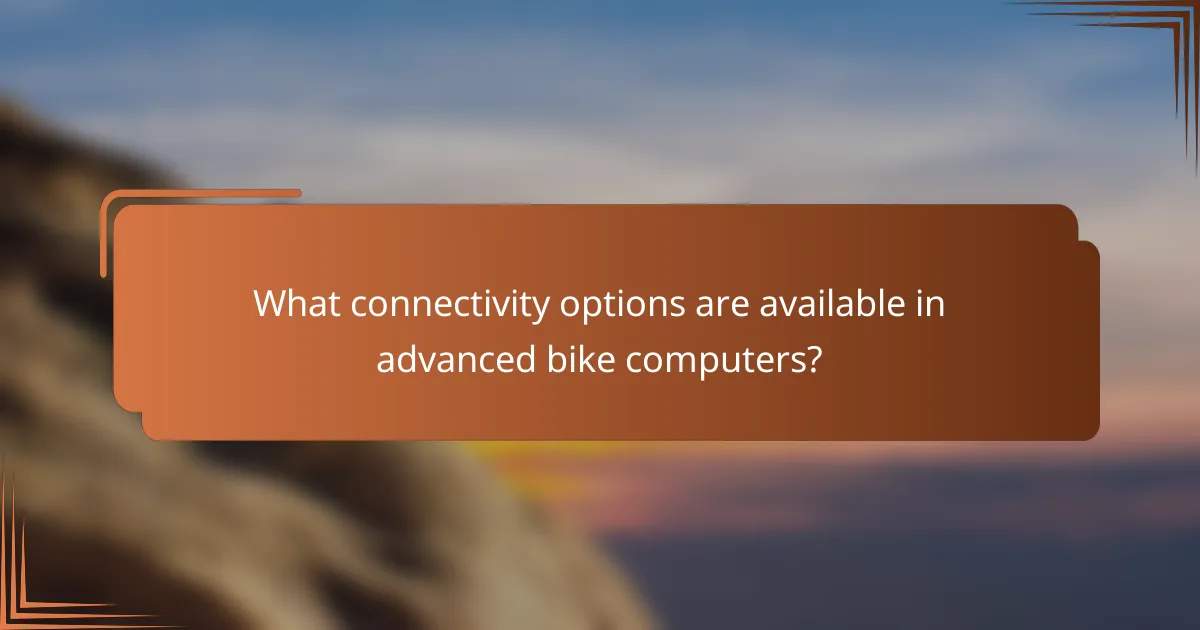Advanced bike computers significantly enhance cycling experiences through their navigation features, connectivity options, and comprehensive data tracking. They provide essential tools like GPS functionality and turn-by-turn directions for improved navigation. Connectivity options such as Bluetooth and ANT+ enable seamless integration with smartphones and sensors. Additionally, these devices track performance metrics like speed and elevation, offering valuable insights for cyclists.

What are the essential navigation features of advanced bike computers?
Advanced bike computers feature essential navigation tools that enhance cycling experiences. Key features include GPS functionality, route planning, turn-by-turn directions, and real-time tracking. GPS provides accurate location data, while route planning allows users to create custom paths. Turn-by-turn directions offer guidance, ensuring cyclists stay on track. Real-time tracking enables monitoring of distance and speed, enhancing performance insights. These features collectively improve navigation and overall cycling efficiency.
How do GPS and mapping capabilities enhance cycling experiences?
GPS and mapping capabilities significantly enhance cycling experiences by providing real-time navigation, route optimization, and tracking features. Advanced bike computers offer turn-by-turn directions, ensuring cyclists stay on course. Connectivity options allow integration with smartphones for notifications and additional apps. Data tracking features help cyclists monitor performance metrics like speed, distance, and elevation gain, leading to improved training and enjoyment. These attributes make cycling more efficient and enjoyable, catering to both casual riders and serious athletes.
Which software integrations improve route planning and navigation?
Integrating advanced bike computers with software solutions enhances route planning and navigation. Key integrations include GPS mapping apps, fitness tracking platforms, and real-time traffic updates. These tools improve navigation accuracy, provide detailed route options, and enable performance tracking. Popular software integrations are Strava, Komoot, and Google Maps, each offering unique features for cyclists.
What role do turn-by-turn directions play in user safety?
Turn-by-turn directions significantly enhance user safety by providing real-time guidance and minimizing distractions. These features help cyclists navigate complex routes, reducing the risk of accidents. Advanced bike computers offer voice prompts and visual cues, allowing users to focus on their surroundings rather than reading maps. Additionally, the integration of connectivity options enables sharing of location data with emergency contacts, further improving safety measures.
How do advanced bike computers adapt to different terrains and environments?
Advanced bike computers adapt to different terrains and environments by utilizing GPS, altimeters, and sensors. These features enable real-time data tracking and navigation adjustments based on elevation changes and surface types. For example, advanced models can switch settings for road cycling versus mountain biking, optimizing performance metrics. Connectivity options further enhance adaptability by allowing integration with weather updates and route planning tools, ensuring cyclists receive relevant information for their specific environment.

What connectivity options are available in advanced bike computers?
Advanced bike computers typically offer several connectivity options, including Bluetooth, ANT+, Wi-Fi, and USB. Bluetooth allows for real-time syncing with smartphones, while ANT+ connects to sensors like heart rate monitors. Wi-Fi enables automatic updates and data uploads. USB ports facilitate direct data transfer to computers. These features enhance user experience by providing seamless integration with various devices and applications.
How does Bluetooth connectivity impact device functionality?
Bluetooth connectivity enhances device functionality by enabling seamless communication between advanced bike computers and other devices. This integration allows for real-time data sharing, navigation updates, and remote control features. For instance, users can sync their bike computers with smartphones to receive notifications, track performance metrics, and access mapping services. The unique attribute of Bluetooth connectivity is its ability to maintain a stable connection while being energy-efficient, which is crucial for long rides. Additionally, rare features like multi-device pairing can further expand the functionality, allowing cyclists to connect to heart rate monitors or other sensors simultaneously.
What advantages does ANT+ technology offer for data sharing?
ANT+ technology enhances data sharing by enabling seamless connectivity between devices. This allows cyclists to access real-time metrics from various sensors, improving performance tracking. ANT+ supports multiple devices simultaneously, ensuring efficient data management during rides. Its low-power consumption extends battery life, making it ideal for extended cycling sessions.
Which smartphone applications are commonly paired with bike computers?
Common smartphone applications paired with bike computers include Strava, Garmin Connect, Wahoo Fitness, MapMyRide, and Komoot. These apps enhance navigation, connectivity, and data tracking features. Strava offers social sharing and performance analysis, while Garmin Connect provides comprehensive metrics and syncing options. Wahoo Fitness focuses on real-time data tracking, and MapMyRide emphasizes route planning. Komoot excels in detailed navigation and offline maps.

How do advanced bike computers track cycling performance data?
Advanced bike computers track cycling performance data using GPS, heart rate monitors, and cadence sensors. These devices collect metrics such as speed, distance, elevation, and power output. Advanced models often feature connectivity options like Bluetooth and ANT+, enabling real-time data sharing with smartphones and other devices. They may also offer navigation features, including route mapping and turn-by-turn directions, enhancing the cycling experience. Unique attributes include customizable displays and integration with training apps, allowing cyclists to analyze their performance comprehensively.
What key metrics do these devices measure during rides?
Advanced bike computers measure several key metrics during rides, including speed, distance, elevation, and GPS navigation. These devices also track heart rate, cadence, and power output, providing cyclists with comprehensive data for performance analysis. The integration of connectivity options enhances data sharing and real-time updates, enriching the riding experience.
How can users analyze their performance data over time?
Users can analyze their performance data over time by utilizing the data tracking features of advanced bike computers. These devices record metrics such as speed, distance, and heart rate, allowing users to view trends and improvements. Many models offer connectivity options that sync data with apps or platforms, enabling detailed analysis and comparisons over different time periods. Users can set goals and monitor progress through visual graphs and reports, enhancing their training strategies.
What are the benefits of heart rate monitoring in cycling?
Heart rate monitoring in cycling enhances performance and safety by providing real-time data. It helps cyclists optimize training intensity, ensuring they remain in target heart rate zones for effective workouts. Additionally, monitoring heart rate can prevent overtraining and reduce the risk of cardiovascular issues. Advanced bike computers utilize this data, offering connectivity options to sync with fitness apps for comprehensive tracking and analysis.

What unique attributes differentiate high-end bike computers from budget models?
High-end bike computers offer superior navigation features, advanced connectivity options, and enhanced data tracking compared to budget models.
High-end models typically include GPS navigation with real-time updates and route planning. They often support multiple satellite systems, improving accuracy and reliability. Connectivity options in premium devices include Bluetooth and ANT+ for seamless integration with other devices, such as heart rate monitors and smartwatches.
Data tracking capabilities are more extensive in high-end models, providing advanced metrics like VO2 max, recovery time, and training load analysis. These features help serious cyclists optimize their performance.
Unique attributes of high-end bike computers include customizable displays and compatibility with smartphone apps for enhanced user experience. Budget models may lack these personalized features, limiting their functionality.
How does battery life vary among different models?
Battery life varies significantly among advanced bike computer models, influenced by features like connectivity and data tracking. High-end models often offer longer battery life, typically ranging from 15 to 40 hours, while basic models may last between 8 to 15 hours. Factors such as GPS usage, screen brightness, and connectivity options like Bluetooth and Wi-Fi can further impact battery performance. For instance, models with extensive navigation features may consume more power, leading to reduced overall battery life.
What advanced sensors are included in premium bike computers?
Premium bike computers include advanced sensors like GPS, barometric altimeters, heart rate monitors, and cadence sensors. These features enhance navigation, track performance, and provide real-time data. GPS sensors offer precise location tracking, while barometric altimeters measure altitude changes. Heart rate monitors assess fitness levels, and cadence sensors measure pedaling speed. Together, these sensors deliver comprehensive cycling metrics for enhanced performance analysis.
How do user interfaces differ between various brands?
User interfaces in advanced bike computers vary significantly across brands, focusing on navigation features, connectivity options, and data tracking.
Some brands prioritize intuitive touchscreens, while others utilize buttons for navigation. Connectivity options differ, with some models offering Bluetooth and Wi-Fi, while others may only support basic syncing. Data tracking capabilities also vary; for instance, certain brands provide advanced metrics like heart rate and power output, whereas others focus on essential speed and distance tracking.
This diversity reflects each brand’s unique approach to enhancing user experience and meeting specific cycling needs.

What rare features should cyclists look for in premium bike computers?
Cyclists should seek unique features in premium bike computers that enhance navigation and connectivity. Look for advanced mapping capabilities, real-time traffic updates, and customizable alerts. These features improve route planning and safety. Additionally, consider compatibility with smart devices and integration with training apps for comprehensive data tracking.
How do advanced bike computers handle weather conditions and durability?
Advanced bike computers are designed to withstand various weather conditions and ensure durability. They typically feature waterproof ratings, often achieving IPX7 or higher, which protects against rain and splashes. Additionally, many models use rugged materials to resist impacts and vibrations. Some advanced bike computers incorporate temperature sensors that adjust performance based on environmental conditions. Enhanced battery life is another attribute, allowing devices to operate longer during extreme weather. These features collectively ensure reliability for cyclists in diverse climates.
What innovative features are emerging in the latest models?
Innovative features in advanced bike computers include enhanced GPS navigation, real-time connectivity with smartphones, and sophisticated data tracking capabilities. These models often offer turn-by-turn directions, live traffic updates, and integration with fitness apps. Unique attributes such as customizable dashboards and advanced analytics provide cyclists with tailored insights for performance improvement. Additionally, rare features like voice commands and compatibility with smart home devices enhance user experience and convenience.
How does customization enhance user experience?
Customization significantly enhances user experience by tailoring advanced bike computers to individual preferences. Users can select navigation features, connectivity options, and data tracking metrics that align with their cycling habits. This personalization leads to improved usability and satisfaction. For instance, customizable dashboards allow riders to prioritize the information they deem most important, such as speed or heart rate. Additionally, integrating connectivity with smartphones enables seamless access to apps, enhancing functionality. Overall, these tailored features create a more engaging and effective cycling experience.

What practical tips can enhance the use of advanced bike computers?
To enhance the use of advanced bike computers, prioritize familiarizing yourself with navigation features, connectivity options, and data tracking capabilities. Regularly update software to access new functionalities. Customize data screens to display relevant metrics for your rides. Utilize smartphone connectivity for real-time updates and notifications. Explore third-party apps for enhanced data analysis and route planning. Engage with online communities for tips and tricks specific to your bike computer model.
How can users optimize settings for better performance tracking?
To optimize settings for better performance tracking on advanced bike computers, users should adjust data display, connectivity preferences, and sensor calibration. Start by customizing the data fields to highlight metrics like speed, distance, and heart rate. Ensure Bluetooth or ANT+ connections are enabled for real-time syncing with wearable devices. Regularly calibrate sensors, such as cadence and power meters, to maintain accuracy. Additionally, update firmware to access the latest features and improvements.
What common mistakes should cyclists avoid when using these devices?
Cyclists should avoid common mistakes like neglecting device updates, failing to calibrate sensors, and overlooking battery life. These errors can hinder navigation accuracy and data tracking. Properly setting up connectivity options is essential for optimal performance. Always familiarize yourself with features before rides to enhance your cycling experience.
How can regular updates improve device functionality and user experience?
Regular updates enhance device functionality and user experience by providing improved navigation features, better connectivity options, and refined data tracking. These updates can fix bugs, optimize performance, and introduce new features that keep advanced bike computers competitive and user-friendly. Enhanced navigation features may include updated maps and routing algorithms, while connectivity options can expand compatibility with other devices. Data tracking improvements may offer more accurate metrics and insights, ultimately leading to a more satisfying cycling experience.